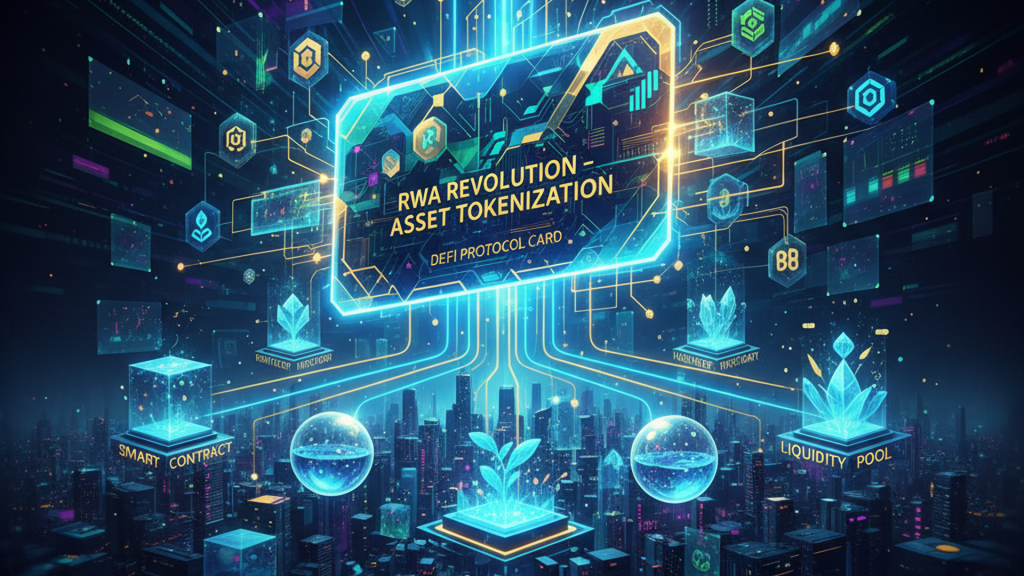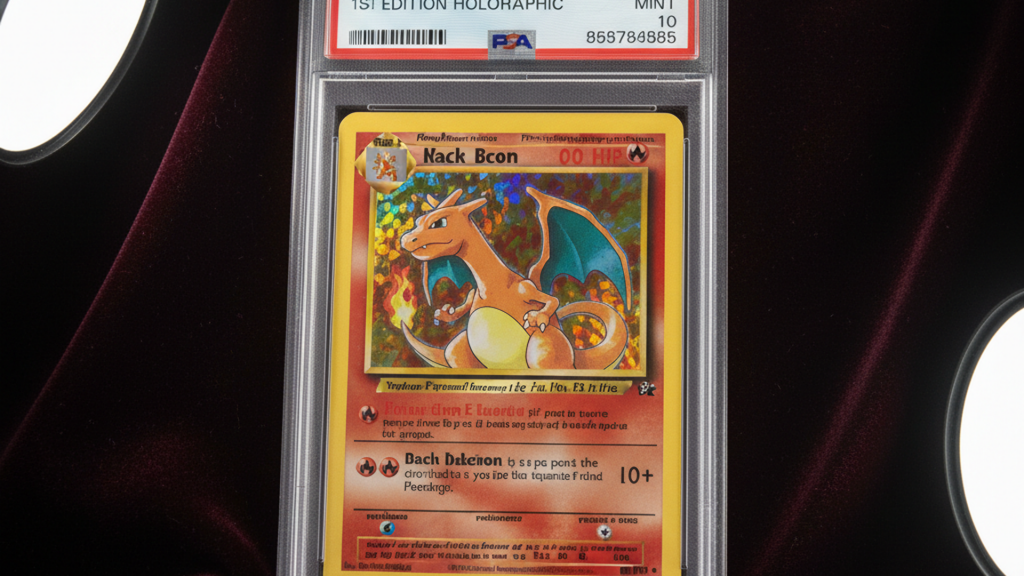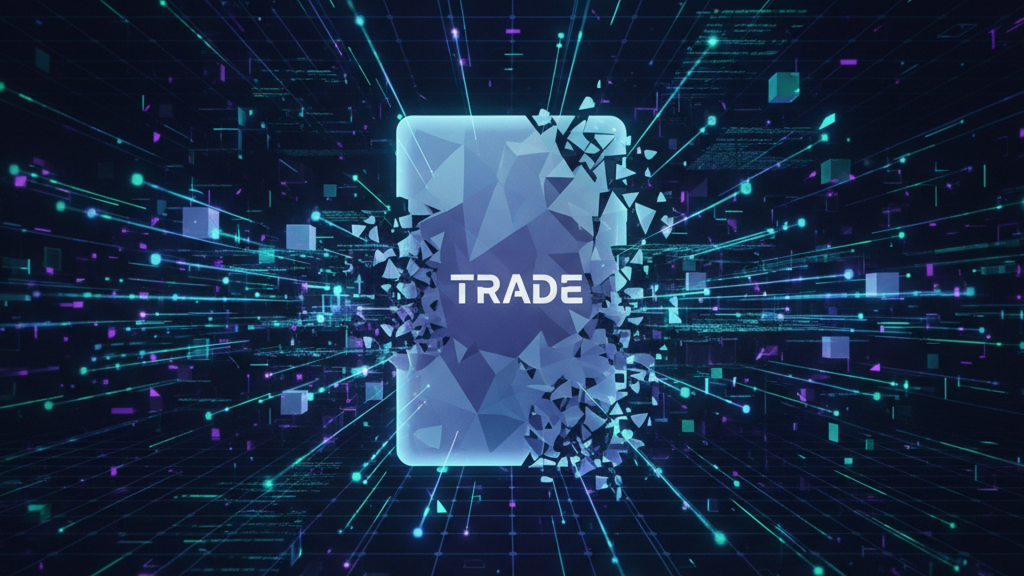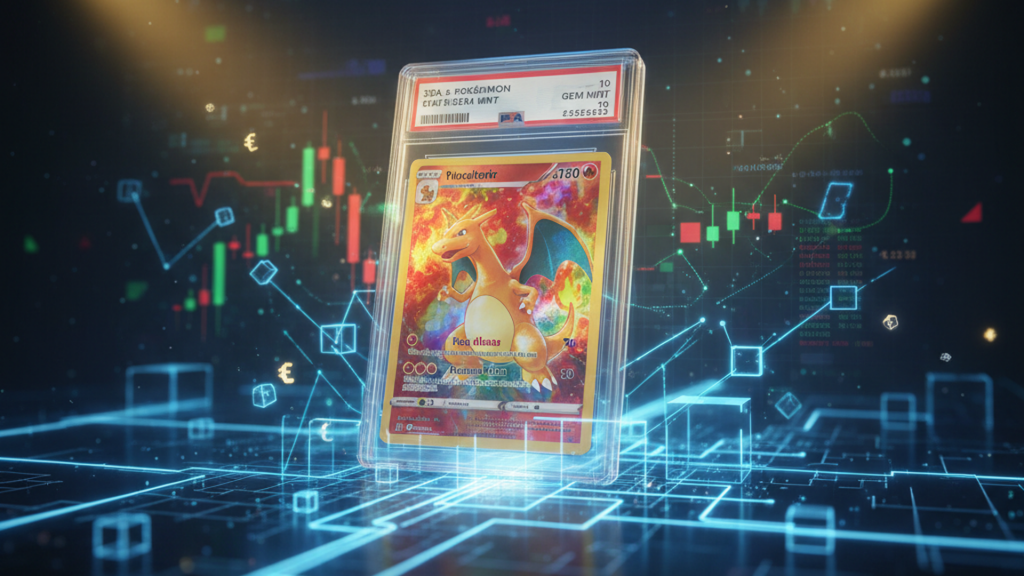Gotta Catch ‘Em All: Why Pokémon Cards Are Becoming a Serious Multi-Billion Dollar Asset Class on the Blockchain

Introduction: From Nostalgia to Net Worth – The Financialization of Cardboard
What was once the currency of the schoolyard—a holographic Charizard traded for a stack of lesser monsters—has evolved into a sophisticated, globally traded asset class. The simple joy of collecting Pokémon cards has given way to a multi-billion dollar market where a single piece of cardboard, encased in plastic and assigned a grade, can command prices exceeding that of a luxury car or even a house. A first edition Base Set Charizard, for instance, sold for $420,000 in 2022, while the ultra-rare Pikachu Illustrator card fetched an astonishing $5.275 million, as detailed in BlockApps’ analysis of the TCG market. This is the new reality of collectibles as a serious alternative investment.
The tokenization of Trading Card Games (TCGs) represents a pivotal case study for the entire Real-World Asset (RWA) thesis. It demonstrates how blockchain technology can inject unprecedented liquidity, transparency, and efficiency into a culturally resonant, yet historically fragmented and inefficient market. This convergence is not merely a niche trend; it is the financialization of nostalgia, powered by decentralized infrastructure. However, the current iteration of this market is being propelled by highly speculative, gamified models that present significant, under-appreciated risks alongside immense opportunity. This report dissects the financial infrastructure, key market players, and the critical risk/reward matrix for investors navigating this new frontier where childhood memories are being repriced on-chain.
The RWA Revolution: DeFi’s Search for Yield and Stability in a Trillion-Dollar Market
To understand the significance of a tokenized Pokémon card, one must first grasp the macro-narrative driving its existence: the rise of Real-World Assets (RWAs). In the context of decentralized finance (DeFi), RWAs are blockchain-based tokens that, as Tangem’s RWA guide explains, digitally represent ownership of tangible, off-chain assets. This category is vast, encompassing everything from traditional financial instruments like bonds and equities to physical assets such as real estate, fine art, and, now, collectibles, a category detailed by Coinbase. The core proposition is to bridge the colossal value locked in the “real world”—a market estimated in the hundreds of trillions of dollars—with the nascent, but highly efficient, rails of DeFi.
This is not a theoretical exercise; it is the next logical, and necessary, evolutionary step for the crypto ecosystem. The growth has been explosive. The market capitalization of tokenized RWAs surged by 260% in 2025, expanding from $8.6 billion to over $23 billion, according to reporting by The Defiant. This capital influx is directly feeding into the DeFi ecosystem, particularly its lending markets. DeFi lending protocols, which rely on high-quality collateral to function, saw their Total Value Locked (TVL) increase by 72% year-to-date in 2025 to over $127 billion, a growth explicitly attributed to the accelerating institutional adoption of tokenized assets.

The reason for this rapid integration is structural. DeFi, in its early stages, has been a largely self-referential system, with volatile crypto-native assets like ETH and BTC serving as the primary forms of collateral. This inherent volatility makes it difficult to build sustainable, long-term credit markets, a key challenge for DeFi that RWAs aim to solve. RWAs provide a solution by introducing stable, often yield-bearing, and uncorrelated assets onto the blockchain. The current RWA landscape is dominated by tokenized private credit and U.S. Treasury debt, which together account for 92% of the market. This demonstrates a clear and powerful demand from within DeFi for the stability and predictable cash flows that real-world assets provide. The emergence of more “exotic” RWAs like TCGs is not happening in a vacuum; it is an attempt to expand this bridge, moving beyond pure financial instruments to tap into the immense value stored in cultural assets, all driven by DeFi’s foundational need for tangible, off-chain value.
Analysis: The TCG Market’s Parabolic Rise to a Legitimate Asset Class
Before their debut on the blockchain, Trading Card Games had already cemented themselves as a formidable, standalone asset class. The global TCG market is a multi-billion dollar industry with a robust growth trajectory, underscoring the deep and sustained demand that makes it an attractive candidate for tokenization.
Quantifying the Physical Market
The scale of the TCG market is substantial and expanding. While estimates vary across market research firms, the consensus points toward significant and sustained growth. Valuations for 2022-2024 range from $6.4 billion to $13 billion, with forecasts projecting the market to reach between $11.57 billion and $21 billion by the early 2030s. This growth is supported by compound annual growth rates (CAGRs) consistently pegged between 5.0% and 8.5%.
| Report Source | Base Year Value (2022-2024) | Forecast Year Value (2030-2034) | Projected CAGR |
|---|---|---|---|
| Zion Market Research | $7.43 Billion (2024) | $15.84 Billion (2034) | 7.86% |
| Market Decipher | $13 Billion (2024) | $21 Billion (2034) | 8.5% |
| TechSci Research | $6.40 Billion (2022) | Not specified | 8.1% (through 2028) |
| Blockapps | $6.39 Billion (2022) | $11.57 Billion (2030) | 7.69% |
| Business Research Insights | $1.0 Billion (2024) | $1.65 Billion (2033) | 5.0% |
This growth is not confined to niche hobby shops. Mainstream retail giants have witnessed a parabolic surge in demand. Walmart Marketplace reported a staggering 200% increase in trading card sales between February 2024 and June 2025, with Pokémon card sales specifically growing more than tenfold year-over-year, as reported by The Economic Times. Target is on a similar trajectory, reporting a nearly 70% increase in TCG sales in 2025 and is on track to surpass $1 billion in this category for the year.

Crucially, this boom is driven by a fundamental shift in consumer behavior. The market is no longer dominated by children playing the game but by adults collecting and investing. Data from market research firm Circana reveals that nearly one in five adults reported purchasing Pokémon cards for themselves, yet only a quarter of those individuals actually play the game. This pivot from “play value” to “investment value” is the critical transformation that makes TCGs suitable for financialization as an RWA. The asset’s primary function has evolved from utility to a store of value, aligning it with other collectible asset classes like fine art, wine, and classic cars.
Documenting Asset Performance
The investment thesis is supported by hard data demonstrating remarkable returns, often outperforming traditional financial markets. The performance of specific, high-demand cards has been nothing short of spectacular. For instance, the modern M Rayquaza EX (Shiny Full Art) card from the Ancient Origins set soared in value by over 426% in 2025 alone, climbing from approximately $275 to $1,450, a trend tracked by IGN. This is not an isolated event; analysis of the modern Pokémon card market shows that the growth rate for booster boxes accelerated by over 162% year-over-year, while certain graded “slab” cards saw their growth rate accelerate by over 200% in the same period, based on market overheating analysis.
This phenomenon is not limited to Pokémon. The market for Magic: The Gathering, the original TCG, provides a longer historical record of performance. High-end, “Reserved List” cards (a list of cards the publisher has promised never to reprint) have proven to be exceptional long-term investments. An Unlimited Edition Black Lotus, one of the game’s most iconic cards, was valued at around $800 in 2006. Today, even a heavily played copy sells for $10,000. This represents a 1,150% gain over 17 years, equating to an average annual return of 67%—dwarfing the S&P 500’s approximate 6.7% annual return over the same period, a performance differential highlighted by TCGplayer Finance. This history of significant value appreciation provides a fundamental basis for TCGs to be considered a legitimate alternative asset class, ripe for the efficiency and liquidity enhancements that blockchain technology promises.
The On-Chain Arena: A Tale of Two Blockchains and $120M+ in Monthly Volume
The theoretical benefits of tokenizing collectibles are now being actualized by a new wave of on-chain platforms. These marketplaces directly address the core frictions of the physical TCG market: exorbitant intermediary fees (eBay’s seller fees can reach ~13%), painfully slow settlement times that depend on physical shipping, and the persistent risk of counterfeit goods, problems that on-chain trading aims to solve. By representing physical cards as digital tokens, these platforms enable instant, global, and low-cost trading. In August 2025, the tokenized Pokémon card market alone saw transaction volume surge fivefold since January to reach $124.5 million, according to data from BloomingBit. This burgeoning market is currently dominated by two key players, each pursuing a distinct strategy on a different blockchain.
Case Study 1: Courtyard.io (Polygon) – The Institutional Approach
Operating on the Polygon blockchain, Courtyard.io has positioned itself as the institutional-grade gateway for tokenizing physical collectibles. Backed by a formidable $37 million in venture funding from top-tier investors including Y Combinator, NEA, and Forerunner Ventures, Courtyard’s model is built on trust and security, as outlined in its token sale analytics. The platform’s core premise involves users sending their professionally graded cards to a secure vault managed and insured by Brink’s, a partnership central to their model. Once vaulted, a corresponding NFT—a “digital twin”—is minted on Polygon, creating a world of connected collectibles that can then be traded freely.
This model has gained significant traction, with Courtyard generating nearly $80 million in secondary sales volume in August 2025 alone, marking its most successful month to date. The platform’s strategy is centered on onboarding mainstream collectors by abstracting away the complexities of crypto. It facilitates purchases via credit card and utilizes embedded wallets to manage gas fees on behalf of the user, creating a seamless experience that feels more like a traditional e-commerce site than a crypto DApp, a user-friendly approach detailed by Privy.
Case Study 2: Collector Crypt (Solana) – The Crypto-Native Disruptor
In contrast to Courtyard’s measured, institutional approach, Collector Crypt has emerged on the Solana blockchain as a fast-moving, crypto-native disruptor. Focused exclusively on Pokémon cards, the platform’s strategy is deeply intertwined with tokenomics and gamification, positioning it for what some call a ‘Polymarket moment’. It launched a native utility token, $CARDS, which experienced a parabolic surge of over 10x within a week of its debut, briefly touching a fully diluted valuation of nearly $500 million.
Collector Crypt’s primary engine for user acquisition and revenue is its “Gacha Machine,” a lottery-style game where users pay to open digital packs containing a random tokenized Pokémon card. This highly engaging, albeit speculative, feature has proven immensely popular, generating $16.6 million in revenue in a single week. The platform’s overall trading volume is catching up to the market leader, hitting $44 million in August 2025.
The divergence between these two platforms is stark. Courtyard is executing a top-down, “TradFi-friendly” strategy, prioritizing partnerships with established security firms like Brink’s and focusing on a user experience designed to attract capital from outside the existing crypto ecosystem. Collector Crypt is pursuing a bottom-up, “crypto-native” strategy, using the speculative allure of a new token and the addictive nature of gamified mechanics to bootstrap liquidity and capture the attention of DeFi traders. The long-term viability of each model remains to be seen, presenting a clear strategic choice for investors based on their appetite for regulatory risk versus execution risk.
| Feature | Courtyard.io | Collector Crypt |
| Blockchain | Polygon | Solana |
| Key Backers | Y Combinator, NEA, Forerunner Ventures | Community-funded via token sale |
| Vaulting Partner | Brink’s | In-house / Third-party (unspecified) |
| Monthly Volume (Aug 2025) | ~$80 Million | ~$44 Million |
| Core Business Model | Marketplace, “Vending Machine” | Gamified “Gacha Machine,” Marketplace |
| Native Token | No | Yes ($CARDS) |
| Target Audience | Mainstream collectors, Web2 users | Crypto-native traders, DeFi users |
The Infrastructure of Value: The Triad of Grading, Vaulting, and Fractionalization
The transformation of a piece of cardboard into a liquid, tradable digital asset is not a simple act of minting an NFT. It relies on a sophisticated, multi-layered infrastructure designed to establish and preserve value. This infrastructure rests on three critical pillars: professional grading, secure physical vaulting, and the financial innovation of fractionalization.
Bedrock of Value: Professional Grading
The entire investment-grade collectibles market is built upon the foundation of third-party authentication and condition grading. Reputable, independent firms such as PSA (Professional Sports Authenticator), Beckett (BAS), and CGC (Certified Guaranty Company) serve as the universally accepted arbiters of value. Their role is to first verify a card’s authenticity and then meticulously assess its physical condition based on four key criteria: centering, corners, edges, and surface. The card is then assigned a grade on a 10-point scale and encapsulated in a tamper-evident plastic case, or “slab,” completing the official grading service.
This process is the non-negotiable first step in converting a collectible into a financial asset. The grade assigned has a profound impact on value, creating an exponential price curve. For a highly coveted card like the 1999 1st Edition Holo Charizard, the difference between a PSA 9 (Mint) and a PSA 10 (Gem Mint) is staggering. While a PSA 9 commands a price of around $20,000, a PSA 10 is valued at approximately $375,000—an 18-fold increase for what may be microscopic imperfections imperceptible to the untrained eye, illustrating the science of what makes a PSA 10. This standardized, trusted grading system is what allows for a global, fungible market where buyers can transact with confidence, knowing exactly the quality of the asset they are acquiring.
The Physical Anchor: Secure Vaulting and Insurance
A digital token representing a physical asset is fundamentally a claim on that asset. The value of that claim is therefore entirely dependent on the security and integrity of the underlying physical object. This introduces a critical element of centralization and counterparty risk into the RWA model, a key legal and structural consideration. The solution is specialized, high-security vaulting services.
Companies like Brink’s and PSA have established state-of-the-art modular vaults designed specifically for high-value collectibles. These vaults offer climate control to prevent degradation, 24/7 professional security, and comprehensive insurance coverage, as detailed by the PSA Vault service. This physical security is then complemented by specialized insurance products. Firms like Evertas are pioneering crypto insurance coverage for both the physical assets in storage and the digital tokens representing them, offering policies that protect against theft, loss, and damage caused by both external attacks and insider threats. This robust infrastructure of physical security and financial insurance is essential for building the institutional trust required for the market to scale.
Unlocking Liquidity: Fractional NFTs (F-NFTs)
While grading establishes value and vaulting secures it, fractionalization is the financial innovation that unlocks its liquidity. The process typically involves locking a single, unique NFT (an ERC-721 token representing one specific card) into a smart contract. This contract then mints a predetermined number of fungible tokens (typically ERC-20 tokens) that represent proportional ownership shares in the underlying asset, a process known as F-NFTs.
This mechanism has two profound benefits. First, it democratizes access. A historically significant asset like the 1909-11 T206 Honus Wagner baseball card, with a market cap of $520,000, becomes accessible to a broader investor base when it can be purchased in $52 shares, as offered by pioneering fractional ownership companies like Rally. Second, and more importantly for the broader DeFi ecosystem, it transforms a single, illiquid asset into a pool of thousands of liquid, fungible tokens.
This transformation is the key to integrating collectibles into the functional machinery of DeFi. A single $250,000 Charizard NFT, like the grail auctioned by Courtyard.io and Polygon Labs, is effectively useless as collateral in a lending protocol. Its market is thin, price discovery is infrequent (occurring only at auction), and it cannot be quickly liquidated to cover a defaulted loan. However, thousands of fungible ERC-20 tokens representing that same Charizard can be traded 24/7 on decentralized exchanges (DEXs). This creates a deep, liquid market and allows price oracles—the data feeds that power DeFi—to establish a reliable, real-time valuation for the asset. This continuous price feed and high liquidity make the fractionalized tokens viable as collateral, opening up possibilities for lending, borrowing, and other yield-generating strategies that were previously impossible for physical collectibles.
The Investor’s Dilemma: A Sober Look at the Risk/Reward Matrix
The tokenization of TCGs presents a compelling, high-growth investment thesis. However, the nascent state of the market, coupled with its crypto-native elements, introduces a complex set of risks that must be weighed against the potential rewards.
The Bull Case (The Reward)
The arguments in favor of this new asset class are rooted in the fundamental improvements that blockchain technology brings to an inefficient market.
- Global, 24/7 Liquidity: Tokenization shatters the geographical and time-based constraints of the physical market. An asset vaulted in Delaware can be traded instantly between investors in Tokyo and London, creating a single, unified global order book that operates around the clock, one of the key revolutions brought by blockchain.
- DeFi Integration and New Yield Streams: The ultimate vision extends beyond simple trading. The ability to use tokenized TCGs as collateral in DeFi lending protocols could unlock new forms of yield. Investors could potentially borrow against their collection to fund other investments or lend out their assets to earn interest, transforming a static collectible into a productive financial asset, one of the many potential use cases for RWA tokenization.
- Reduced Friction and Costs: On-chain marketplaces offer a dramatic reduction in transaction costs. Platforms like Collector Crypt charge a 4% fee, a significant improvement over the ~13% taken by traditional platforms like eBay. Furthermore, settlement is near-instantaneous, eliminating the delays and risks associated with physical shipping.
- Enhanced Provenance and Transparency: The blockchain acts as an immutable, public ledger, providing a transparent and tamper-proof record of an asset’s ownership history. Every transaction is recorded, creating a clear chain of custody that enhances trust and helps combat fraud.

The Bear Case (The Risk)
Despite the powerful bull case, investors must contend with significant and unique risks inherent to this new market structure.
- Centralization and Counterparty Risk: This is the Achilles’ heel of the entire physically-backed RWA model. While the digital tokens are decentralized, their value is entirely dependent on a centralized, trusted third party—the vaulting company. A security breach, operational failure, fraud, or insolvency at the vaulting provider could render the digital tokens worthless, with little recourse for token holders. This is a fundamental trade-off: in exchange for digital liquidity, the investor sacrifices physical custody and accepts significant counterparty risk.
- Unsustainable Business Models: The explosive initial growth of platforms like Collector Crypt and Courtyard is heavily reliant on gamified “gacha” or “vending machine” mechanics. These systems, which offer the chance to win a high-value card from a randomized pack, function more like online casinos than traditional investment platforms, a sentiment echoed by users receiving free credits. This business model faces a dual threat: the potential for significant regulatory scrutiny related to gambling laws, and the question of its long-term sustainability once the initial speculative fervor subsides.
- Regulatory and Intellectual Property Uncertainty: The current platforms operate in a legal gray area. Fractionalized assets could potentially be classified as securities by regulators like the U.S. Securities and Exchange Commission (SEC), which would impose massive compliance costs and legal challenges, a known complexity of fractional NFT ownership. Even more pressing is the intellectual property risk. These platforms are creating derivative digital products based on IP owned by companies like The Pokémon Company, which has a history of aggressively defending its trademarks and has explicitly stated its disapproval of unofficial NFT projects, highlighting a key risk of investing in NFTs.
- Smart Contract and Market Volatility: All the standard risks of the crypto market apply. A bug or exploit in a platform’s smart contracts could lead to a total loss of funds, one of the primary technical risks of NFTs. Additionally, investors are exposed to multiple layers of volatility: the price of the underlying collectible, the value of the NFT representing it (which can trade at a premium or discount), and, for platforms like Collector Crypt, the extreme volatility of the native platform token ($CARDS), whose price action has been closely watched.
| Risk Factor | Physical TCGs (Self-Custody) | Tokenized TCGs (Vaulted) |
|---|---|---|
| Liquidity Risk | High (Slow, fragmented market) | Low (Global, 24/7 market) |
| Counterfeit/Authentication Risk | Moderate (Requires expert verification) | Low (Pre-authenticated by grading services) |
| Physical Security/Theft Risk | High (Dependent on owner’s security) | Low (Secured in professional, insured vaults) |
| Counterparty Risk (Vault Failure) | None | High (Dependent on vaulting provider’s integrity) |
| Smart Contract Risk | None | High (Vulnerable to hacks and exploits) |
| Regulatory Risk (IP/Securities) | Low | High (Uncertain legal and IP landscape) |
| Transaction Costs & Speed | High Costs, Slow Settlement | Low Costs, Instant Settlement |
The Final Boss: Navigating Publisher IP and the Future of Collectible Finance
While technical, market, and regulatory risks are significant, the single greatest existential threat to the current on-chain TCG market is the intellectual property holders themselves. The very companies that create the beloved characters and games—The Pokémon Company and Hasbro’s Wizards of the Coast—hold the ultimate power to legitimize or invalidate this entire ecosystem. Their current stances are complex, contradictory, and warrant close examination.
The Pokémon Company’s Paradoxical Stance
The Pokémon Company (TPCi) has presented a publicly hostile and privately strategic face to the world of web3. Officially, the company has been unequivocal. It has issued direct statements declaring that it “has not developed or approved of Non Fungible Tokens (NFTs) related to the Pokémon brand,” a stance it reiterated with the launch of its digital TCG Pocket app. This is not just rhetoric; the company has backed its words with legal action, successfully suing an Australian crypto company for launching an unauthorized Pokémon NFT game called “PokéWorld” in 2022.
However, behind this public wall of opposition, the company is actively preparing for an on-chain future. In June 2024, The Pokémon Company was granted a patent for technology related to distributed ledgers and NFTs, based on an application filed in October 2022. The patent’s stated goal is to “preserve players’ emotional connection to cards in digital TCGs,” and it explicitly describes a system where users can “freely trade and exchange cards” on an NFT platform. This dual-track approach—publicly condemning unofficial projects while privately securing the intellectual property to launch an official one—is a clear signal of intent.
Hasbro/Wizards of the Coast’s Cautious Exploration
The approach of Hasbro, the parent company of Magic: The Gathering publisher Wizards of the Coast, has been more publicly nuanced but similarly protective of its IP. Hasbro’s CEO has openly stated that NFTs represent a “real opportunity” for franchises like Magic. The company has even dipped its toes in the water with a Power Rangers-themed NFT collection on the WAX blockchain.
Yet, this exploration is coupled with a firm defense of its core IP. When a fan-led project called mtgDAO attempted to create an unauthorized NFT-based economy layered on top of Magic: The Gathering, Wizards of the Coast promptly sent a cease-and-desist letter, stating that while the company was “evaluating its future plans regarding NFTs,” the fan project constituted unlawful IP infringement. This indicates a clear desire to control the narrative and capture the value of any future on-chain initiatives themselves.

The unavoidable conclusion is that the current ecosystem of tokenized TCGs exists in a precarious state. Its success is a double-edged sword: it proves the viability of the business model while simultaneously attracting the attention of the IP giants who have the power to render it obsolete overnight. An officially licensed “Pokémon Digital Collectible” or “Magic: The Gathering Arena NFT” platform, backed by the full marketing and legal might of its creators, would almost certainly command the loyalty of the vast majority of collectors and investors. The current third-party platforms are, in effect, running a multi-million dollar proof-of-concept for the very entities that pose the greatest threat to their long-term survival. Their ultimate fate may lie not in out-competing each other, but in being acquired or finding a niche that an official, licensed product does not serve.
Conclusion: A Personal Insight on the Real Alpha
The analysis is clear: Trading Card Games have matured from a childhood hobby into a legitimate, multi-billion dollar alternative asset class. The application of blockchain technology is solving tangible, real-world problems of liquidity, transparency, and transaction costs that have long plagued this market. The on-chain trading volumes, now exceeding $120 million monthly, confirm a powerful product-market fit. However, this nascent ecosystem is fraught with peril. The dominant business models are predicated on speculative, casino-like mechanics that invite regulatory risk, while the entire structure is built on a legal gray area that could be upended at any moment by the entry of the official IP holders.
The current frenzy around tokenized Pokémon cards, with its gacha mechanics and speculative token pumps, is a distraction. The real alpha isn’t in flipping a digital Charizard. It’s in recognizing that this niche market is serving as a high-velocity, real-world stress test for the financial and physical infrastructure—secure vaulting, institutional insurance, fractionalization, and cross-chain liquidity—that will be required to bring the trillions of dollars in traditional assets like real estate, private equity, and fine art on-chain. Pokémon cards are simply the beta test.
For businesses looking to capitalize on the growing interest in digital assets, Aurpay.net offers a robust and secure cryptocurrency payment gateway. Whether you’re an e-commerce merchant, an online business, or a developer, Aurpay enables you to seamlessly accept crypto payments like Bitcoin and other digital assets on your website or online store. With quick integration options for popular platforms like Shopify and WooCommerce, crypto invoice billing, and powerful APIs, Aurpay streamlines cross-border crypto transactions, helping you tap into over 580 million global crypto users. Experience significant cost savings (up to 96% on settlement fees), enhanced security with non-custodial smart contracts and AML/ATF compliance, and features like the Bitcoin Lightning Network for instant, zero-fee transactions. Explore how Aurpay can boost your business by visiting their dedicated pages for crypto payment buttons, e-commerce payment gateways, crypto invoice billing, affiliate programs, smart contract services, and USDT payment solutions. Stay informed on crypto trends and enterprise adoption through their Lightning Network insights, safest crypto investments, and crypto on/off-ramp discussions.

